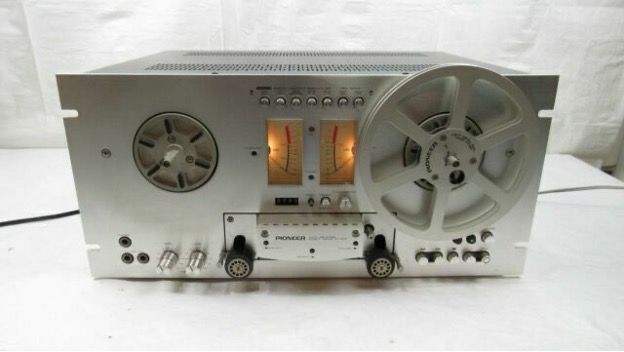Pioneer started with a series of decks in the late 1960s called the T series, with the T-6100 and T-6600 being popular units back in the day. These single motor decks sounded good back in the day, but are now finicky, with multiple problems in them. Any and all of the problems listed at the beginning of this article can affect these early Pioneer decks.
RT-1011 , RT-1020, RT-1050, RT-2022, RT-2044
The above models were made starting around 1974, and switched to direct drive motors for the reel tables, and the capstan motor was belt drive. While they are good sounding decks, and generally reliable, most need a bunch of work done to them. Weak spots include:
– Bad transistors. Hitachi also made the 2SC1344 transistors for Pioneer, and they have the same problem as the Akai decks- the transistors can go dead, noisy or intermittent. The problem is so common, that all of these transistors need to be changed on every deck to be reliable in the long term. These Pioneers aren’t quite as easy to service as the typical Akai, and there’s around 20 transistors usually that need to be changed out to more modern equivalents.
– Worn out pushbutton transport switches. The spring loaded mechanism for the transport switches needs to be lubricated, and I’ve seen a couple of these transports with intermittent function switches, due to the AC voltage and current wearing the switch contacts out. Replacing these switches, or the switch banks is not an easy job, as they are buried right behind the front panel, with no easy way to get to them.
RT-701, 707, 901, 909
These four models were Pioneer’s last line of reel to reel decks, and are highly regarded as being solid performers when dialed in correctly. They are also one of the rare series of decks that are rack mounted, designed to fit into the Pioneer SPEC series of racks (or any other 19” standard rack), giving them a bit of an industrial look that matched a number of their other stereo components.
The RT701 and RT707 models use a direct drive capstan motor, the 901 and 909 use a dual capstan belt drive.
RT-701, 707
– Bad 2SC 1344 transistors. Both of these models use 8 of these transistors that must be changed out when servicing this deck to prevent intermittent audio
– Bad Molex connectors used in the capstan motor, causing a dead capstan motor, or intermittent speed problems.
– Intermittent solder connections. While not rampant in the Pioneer series, it can happen, and the trick is to troubleshoot and trace the bad solder joint, rather than resoldering connections at random.
– Bad bulbs in the direction indicators (RT-707 only). This is a pretty common problem, and the original 24 volt bulbs with insulated wire leads can be tough to find. I use smaller bulbs than the original, with heat shrink around the base of the bulb to properly hold it in place. I generally also put in a dropping resistor in series with one of the bulb wires, to dim them down a bit, but to extend the life a lot more than without it.

RT-901, RT-909
– Using the proper belt. Both of these models have a bit of an under-designed capstan motor drive, and it is absolutely critical that the correct belt is used. Many of the online cross=reference for belts are incorrect, with the belt being too short, or too thick, causing speed problems after the new belt is installed.. or it may happen hours of use down the road, where the deck slows down at random due to a belt being too thick.
– Capstan motor failure- the motor in the 901 and 909 is identical to the 24 volt DC motor used in many Teac X series decks, and these motors are prone to failure. Since these are a servo controlled motor, the exact replacement needs to be used for proper speed control. New motors are long discontinued by Teac and Pioneer, so you’re at the mercy of ebay to find these motors that can range from $250-400 USD as of March 2023. If the heads show significant wear in either of these models, beware that the capstan motor is probably close to end of life. While the motor can be pulled apart and inspected, that’s also a labor intensive job, and there’s always a slight risk of permanently damaging the motor as you’re taking it apart.
– Chip failure- while somewhat rare, the failure of a chip in the logic circuits of fluorescent display PC board can be a nightmare to troubleshoot and repair. Many of the boards in these models of decks are not easily accessible, and the logic circuit is especially complex, taking hours to troubleshoot.
